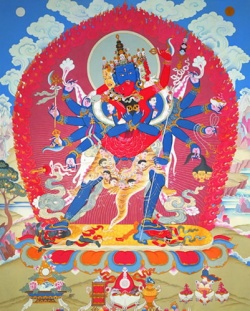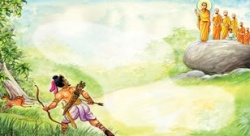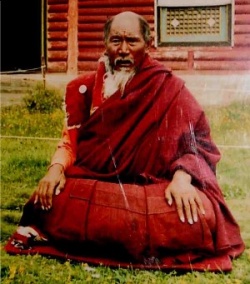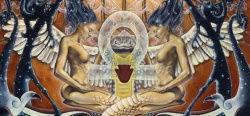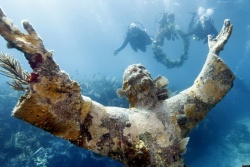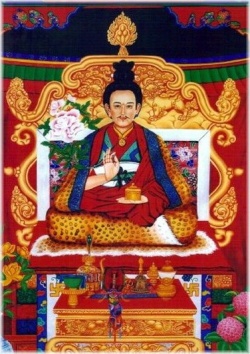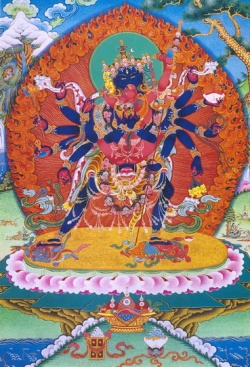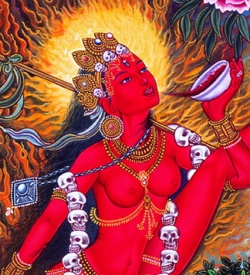Difference between revisions of "The Practices of Heruka & Vajrayogini"
(Created page with "thumb|250px| <poem> The practices of Buddha Heruka and Buddha Vajrayogini are the Highest Yoga Tantra practices of Kadampa [...") |
|||
| (7 intermediate revisions by the same user not shown) | |||
| Line 1: | Line 1: | ||
| − | [[File:Heruka-011.jpg|thumb|250px|]] | + | [[File:Heruka-011.jpg|thumb|250px|]]<nomobile>{{DisplayImages|3404|2341|2689|2575|1582}}</nomobile> |
<poem> | <poem> | ||
The practices of [[Buddha]] [[Heruka]] and [[Buddha]] [[Vajrayogini]] are the [[Highest Yoga Tantra]] practices of [[Kadampa]] [[Buddhism]]. | The practices of [[Buddha]] [[Heruka]] and [[Buddha]] [[Vajrayogini]] are the [[Highest Yoga Tantra]] practices of [[Kadampa]] [[Buddhism]]. | ||
| − | The practice of [[Buddha]] [[Heruka]] is explained in [[Geshe Kelsang]]’s book, {{Wiki|Essence}} of [[Vajrayana]]. and the practice of [[Buddha]] [[Vajrayogini]] is explained in the book Guide to [[Dakini]] | + | The practice of [[Buddha]] [[Heruka]] is explained in [[Geshe Kelsang]]’s [[book]], {{Wiki|Essence}} of [[Vajrayana]]. and the practice of [[Buddha]] [[Vajrayogini]] is explained in the [[book]] Guide to [[Dakini Land]]. |
| − | Empowerment | + | [[Empowerment]] |
| + | |||
| + | Before engaging in either of these practices it is necessary to receive an [[empowerment]] and instructions from a qualified [[Spiritual]] [[Guide]]. These [[empowerments]] are given every other year at International [[Kadampa]] {{Wiki|Festivals}}, and occasionally at other events. | ||
| + | |||
| − | |||
About [[Buddha]] [[Heruka]] | About [[Buddha]] [[Heruka]] | ||
| − | Extracted from the book {{Wiki|Essence}} of [[Vajrayana]] | + | Extracted from the [[book]] {{Wiki|Essence}} of [[Vajrayana]] |
[[File:Heruka_2004.jpg|thumb|250px|]] | [[File:Heruka_2004.jpg|thumb|250px|]] | ||
| − | |||
| − | |||
| − | To lead fortunate [[disciples]] to the state of [[Buddha]] [[Heruka]] within one [[life]], [[Buddha]] [[Vajradhara]] manifested his [[compassion]] in the form of interpretative [[Heruka]], who has a blue-coloured [[body]], four faces, and twelve arms, and embraces his {{Wiki|consort}}, [[Vajravarahi]]. Attaining the state of [[Buddha]] [[Heruka]] depends upon abandoning the twelve dependent-related links of [[samsara]] by gaining the {{Wiki|realizations}} of the four doors of [[liberation]]; and in particular it depends upon realizing the union of great [[bliss]] and [[emptiness]]. These are symbolized respectively by [[Heruka]]’s twelve arms, his four faces, and his embracing [[Vajravarahi]]. | + | “The [[Sanskrit]] term `[[Heruka]]’ is composed of the three {{Wiki|syllables}}, `'''He'''’, `'''ru'''’, and `'''ka'''’. `He’ teaches the [[emptiness]] of [[phenomena]] in general, and `'''ru'''’ the [[emptiness]] of persons in particular; |
| + | |||
| + | together they reveal the [[emptiness]] of all {{Wiki|phenomena}}. `'''Ka'''’ refers to the union of [[Heruka]]’s [[mind]] of great [[bliss]] and the [[emptiness]] of all {{Wiki|phenomena}}. | ||
| + | |||
| + | This union is [[Heruka]]’s [[Truth]] [[Body]]. An I, or [[self]], [[imputed]] on this [[Truth Body]] is definitive [[Heruka]], the real [[nature]] of [[Buddha]] [[Heruka]]. This can only be seen by [[Buddhas]]. | ||
| + | |||
| + | Another term for [[Heruka]] is `[[Chakrasambara]]’. `[[Chakra]]’ means `[[wheel]]’, and in this context refers to the `[[wheel]]’ of all {{Wiki|phenomena}}. `[[Sambara]]’ means the {{Wiki|supreme}} [[bliss]], which is called `{{Wiki|spontaneous}} great [[bliss]]’. | ||
| + | |||
| + | Together `[[Chakra]]’ and `[[sambara]]’ reveal that by practicing [[Heruka Tantra]] we gain a profound [[realization]] that [[experiences]] all {{Wiki|phenomena}} as one [[nature]] with our [[mind]] of great [[bliss]]. | ||
| + | |||
| + | This {{Wiki|realization}} directly removes {{Wiki|subtle}} {{Wiki|dualistic}} [[appearances]] from our [[mind]], and due to this we quickly become definitive [[Heruka]]. | ||
| + | |||
| + | |||
| + | To lead [[fortunate]] [[disciples]] to the [[state]] of [[Buddha]] [[Heruka]] within one [[life]], [[Buddha]] [[Vajradhara]] [[manifested]] his [[compassion]] in the [[form]] of interpretative [[Heruka]], who has a blue-coloured [[body]], four faces, and twelve arms, and embraces his {{Wiki|consort}}, [[Vajravarahi]]. | ||
| + | |||
| + | [[Attaining]] the [[state]] of [[Buddha]] [[Heruka]] depends upon [[abandoning]] the [[twelve dependent-related links]] of [[samsara]] by gaining the {{Wiki|realizations}} of the [[four doors]] of [[liberation]]; | ||
| + | |||
| + | and in particular it depends upon [[realizing]] the union of great [[bliss]] and [[emptiness]]. These are [[symbolized]] respectively by [[Heruka]]’s twelve arms, his four faces, and his embracing [[Vajravarahi]]. | ||
[[File:78vajrayogini-1.jpg|thumb|250px|]] | [[File:78vajrayogini-1.jpg|thumb|250px|]] | ||
| − | |||
| − | |||
| − | [[Buddha]] [[Vajradhara]], [[Buddha]] [[Shakyamuni]], and [[Buddha]] [[Heruka]] are the same person, differing only in aspect. When [[Buddha]] turned the [[Wheel | + | It is possible that those who do not understand the deep meaning of [[Buddha]]’s [[Vajrayana]] teachings may [[feel]] uncomfortable with [[Heruka]]’s {{Wiki|wrathful}} aspect. Such practitioners need to understand that all [[phenomena]] are {{Wiki|equal}} in lacking [[inherent]] [[existence]]. |
| − | + | ||
| − | [[Heruka]] is [[Buddha]]’s [[mind]] of [[compassion]] manifested as [[form]]. Only [[Buddhas]] have the ability to display their [[minds]] as [[form]]. We [[sentient beings]] are unable to do this because our [[mind]] and [[body]] are different natures, but a [[Buddha]]’s [[mind]] and [[body]] are the same nature and so wherever their [[mind]] goes their [[body]] goes too. We always perceive a gap between our [[mind]] and its [[object]]. This is a mistaken [[perception]], or mistaken appearance. Having completely abandoned this mistaken [[perception]], [[Buddhas]] have the ability to display their [[mind]] as [[form]], such as the [[forms]] of living {{Wiki|beings}} and inanimate [[objects]]. For this reason it is said that [[Buddhas]]’ {{Wiki|emanations}} pervade the whole {{Wiki|universe}}. | + | In {{Wiki|ultimate}} [[truth]], [[emptiness]], there are no {{Wiki|wrathful}} or [[peaceful]] aspects because all [[phenomena]] are of one [[nature]]. |
| + | |||
| + | Therefore, those who possess deep [[knowledge]] of {{Wiki|ultimate}} [[truth]] have no basis for developing [[unpleasant]] [[feelings]] upon perceiving unattractive [[objects]] because they realize that ultimately there are no [[truly existent]] unattractive or attractive [[objects]]. | ||
| + | |||
| + | |||
| + | |||
| + | For example, although [[Heruka]]’s long necklace of [[human]] heads may seem to be real, in fact it is a [[manifestation]] of [[Heruka]]’s {{Wiki|omniscient}} [[wisdom]]. | ||
| + | |||
| + | All the various features of [[Heruka]]’s [[body]] are merely [[manifestations]] of his {{Wiki|omniscient}} [[wisdom]] and do not [[exist]] outside of his [[mind]]. | ||
| + | |||
| + | However, for [[faithful]] practitioners, {{Wiki|visualizing}} the {{Wiki|wrathful}} aspect of [[Heruka]] is a powerful method for swiftly receiving his {{Wiki|blessings}} and {{Wiki|protection}}. | ||
| + | |||
| + | It is for this [[reason]], as well as to display in a [[visible]] manner how to progress along the entire [[path]] of [[Sutra]] and [[Tantra]], that [[Buddha]] [[Vajradhara]] emanated the [[wrathful]] [[Deity]] [[Heruka]]. | ||
| + | |||
| + | |||
| + | [[Buddha]] [[Vajradhara]], [[Buddha]] [[Shakyamuni]], and [[Buddha]] [[Heruka]] are the same [[person]], differing only in aspect. When [[Buddha]] turned the [[Wheel of Dharma]] of [[Sutra]] he appeared in the [[form]] of an [[ordained]] [[person]], when he turned the [[Wheel]] of [[Dharma]] of [[Tantra]] in general he appeared in the [[form]] of [[Vajradhara]], and when he turned the [[Wheel]] of [[Dharma]] of [[Heruka]] [[Tantra]] in particular he appeared in the [[form]] of [[Heruka]]. | ||
| + | |||
| + | |||
| + | [[Heruka]] is [[Buddha]]’s [[mind]] of [[compassion]] [[manifested]] as [[form]]. Only [[Buddhas]] have the ability to display their [[minds]] as [[form]]. | ||
| + | |||
| + | We [[sentient beings]] are unable to do this because our [[mind]] and [[body]] are different natures, but a [[Buddha]]’s [[mind]] and [[body]] are the same [[nature]] and so wherever their [[mind]] goes their [[body]] goes too. | ||
| + | |||
| + | We always {{Wiki|perceive}} a gap between our [[mind]] and its [[object]]. This is a mistaken [[perception]], or mistaken [[appearance]]. | ||
| + | |||
| + | Having completely abandoned this mistaken [[perception]], [[Buddhas]] have the ability to display their [[mind]] as [[form]], such as the [[forms]] of living {{Wiki|beings}} and [[inanimate]] [[objects]]. For this [[reason]] it is said that [[Buddhas]]’ {{Wiki|emanations}} pervade the whole {{Wiki|universe}}. | ||
| + | |||
| + | |||
| + | [[Buddha]]’s [[mind]] of {{Wiki|omniscient}} [[wisdom]] has thirty-seven parts, known as his `thirty-seven realizations conducive to [[enlightenment]]’. These thirty-seven realizations appear in the [[form]] of the thirty-seven [[Deities]] of [[Heruka]]’s [[mandala]]. | ||
| + | |||
| + | We normally say that there are sixty-two [[Deities]] in [[Heruka]]’s [[mandala]], but if we count each union of Father and Mother as one [[Deity]] there are thirty-seven [[Deities]]. | ||
| + | |||
| + | The thirty-seven realizations conducive to [[enlightenment]] of [[Bodhisattvas]] are [[causal]] [[paths]] and the thirty-seven realizations of [[Buddhas]] are resultant [[paths]]. A general explanation of these thirty-seven {{Wiki|realizations}} can be found in [[Ocean of Nectar]]. “ | ||
| + | |||
| − | |||
About [[Buddha]] [[Vajrayogini]] | About [[Buddha]] [[Vajrayogini]] | ||
| − | |||
| − | |||
| − | |||
| − | |||
| − | The practice of [[Vajrayogini]] quickly brings {{Wiki|blessings}}, especially during this [[spiritually]] degenerate age. It is said that as the general level of [[spirituality]] decreases, it becomes increasingly difficult for practitioners to receive the {{Wiki|blessings}} of other [[Deities]]; but the opposite is the case with [[Heruka]] and [[Vajrayogini]] – the more times degenerate, the more easily practitioners can receive their blessings. | + | Extracted from the [[book]] Guide to [[Dakini]] Land |
| + | |||
| + | “The two stages of the practice of [[Vajrayogini]] were originally [[taught]] by [[Buddha]] [[Vajradhara]]. He [[manifested]] in the [[form]] of [[Heruka]] to expound the [[Root]] [[Tantra]] of [[Heruka]], and it was in this [[Tantra]] that he explained the practice of [[Vajrayogini]]. | ||
| + | |||
| + | All the many [[lineages]] of instructions on [[Vajrayogini]] can be traced back to this original [[revelation]]. Of these [[lineages]], there are three that are most commonly practised: the [[Narokhachö]] [[lineage]], which was transmitted from [[Vajrayogini]] to [[Naropa]]; | ||
| + | |||
| + | the [[Maitrikhachö]] [[lineage]], which was transmitted from [[Vajrayogini]] to [[Maitripa]]; | ||
| + | |||
| + | and the [[Indrakhachö]] [[lineage]], which was transmitted from [[Vajrayogini]] to [[Indrabodhi]]. This commentary to the [[generation and completion]] stages of the [[Highest]] {{Wiki|Yoga}} [[Tantra]] practice of [[Vajrayogini]] is based on the instructions of the [[Narokhachö]] [[lineage]]. | ||
| + | |||
| + | |||
| + | |||
| + | The instructions on the practice of [[Vajrayogini]] contain concise and clearly presented [[meditations]] that are relatively easy to practise. | ||
| + | |||
| + | The [[mantra]] is short and easy to recite, and the [[visualizations]] of the [[mandala]], the [[Deity]], and the [[body mandala]] are simple compared with those of other [[Highest Yoga Tantra]] [[Deities]]. | ||
| + | |||
| + | Even practitioners with limited {{Wiki|abilities}} and little [[wisdom]] can engage in these practices without great difficulty. | ||
| + | |||
| + | The practice of [[Vajrayogini]] quickly brings {{Wiki|blessings}}, especially during this [[spiritually]] [[degenerate age]]. It is said that as the general level of [[spirituality]] {{Wiki|decreases}}, it becomes increasingly difficult for practitioners to receive the {{Wiki|blessings}} of other [[Deities]]; but the opposite is the case with [[Heruka]] and [[Vajrayogini]] – the more times degenerate, the more easily practitioners can receive their [[blessings]]. | ||
| + | |||
| + | Whenever [[Vajradhara]] expounded a [[Tantra]] he emanated the [[mandala]] associated with it, but after completing the [[discourse]] he would usually reabsorb the [[mandala]]. | ||
| + | |||
| + | For example, when he expounded the [[Root Tantra]] of [[Kalachakra]] he emanated the [[Kalachakra]] [[mandala]], and when he had finished he reabsorbed it. | ||
| + | |||
| + | However, he did not reabsorb the [[mandalas]] of [[Heruka]] or [[Vajrayogini]]. These [[mandalas]] still [[exist]] at various places throughout this [[world]], such as in the twenty-four {{Wiki|holy}} places. | ||
| + | |||
| + | Because of this, [[human beings]] in this [[world]] have a special relationship with [[Heruka]] and [[Vajrayogini]] and can quickly receive their {{Wiki|blessings}}. | ||
| − | + | Furthermore, in the [[Root Tantra]] of [[Heruka]] [[Vajradhara]] promised that in the {{Wiki|future}}, when times became [[spiritually]] degenerate, [[Heruka]] and [[Vajrayogini]] would bestow their [[blessings]] on those with strong [[attachment]]. | |
| − | In general, as the number of [[lineage | + | In general, as the number of [[lineage Gurus]] of a [[Deity]]’s practice increases, the {{Wiki|blessings}} of that [[Deity]] take longer to reach practitioners; but the greater the number of [[lineage]] [[Gurus]] of [[Heruka]] and [[Vajrayogini]], the more quickly practitioners receive their {{Wiki|blessings}}.” |
</poem> | </poem> | ||
{{R}} | {{R}} | ||
[http://kadampa.org/buddhism/heruka-vajrayogini/ kadampa.org] | [http://kadampa.org/buddhism/heruka-vajrayogini/ kadampa.org] | ||
| − | [[Category:Heruka]] | + | [[Category:Heruka]] |
| − | [[Category:Vajrayogini]] | + | [[Category:Vajrayogini practice]] |
Latest revision as of 05:37, 5 May 2018
The practices of Buddha Heruka and Buddha Vajrayogini are the Highest Yoga Tantra practices of Kadampa Buddhism.
The practice of Buddha Heruka is explained in Geshe Kelsang’s book, Essence of Vajrayana. and the practice of Buddha Vajrayogini is explained in the book Guide to Dakini Land.
Empowerment
Before engaging in either of these practices it is necessary to receive an empowerment and instructions from a qualified Spiritual Guide. These empowerments are given every other year at International Kadampa Festivals, and occasionally at other events.
About Buddha Heruka
Extracted from the book Essence of Vajrayana
“The Sanskrit term `Heruka’ is composed of the three syllables, `He’, `ru’, and `ka’. `He’ teaches the emptiness of phenomena in general, and `ru’ the emptiness of persons in particular;
together they reveal the emptiness of all phenomena. `Ka’ refers to the union of Heruka’s mind of great bliss and the emptiness of all phenomena.
This union is Heruka’s Truth Body. An I, or self, imputed on this Truth Body is definitive Heruka, the real nature of Buddha Heruka. This can only be seen by Buddhas.
Another term for Heruka is `Chakrasambara’. `Chakra’ means `wheel’, and in this context refers to the `wheel’ of all phenomena. `Sambara’ means the supreme bliss, which is called `spontaneous great bliss’.
Together `Chakra’ and `sambara’ reveal that by practicing Heruka Tantra we gain a profound realization that experiences all phenomena as one nature with our mind of great bliss.
This realization directly removes subtle dualistic appearances from our mind, and due to this we quickly become definitive Heruka.
To lead fortunate disciples to the state of Buddha Heruka within one life, Buddha Vajradhara manifested his compassion in the form of interpretative Heruka, who has a blue-coloured body, four faces, and twelve arms, and embraces his consort, Vajravarahi.
Attaining the state of Buddha Heruka depends upon abandoning the twelve dependent-related links of samsara by gaining the realizations of the four doors of liberation;
and in particular it depends upon realizing the union of great bliss and emptiness. These are symbolized respectively by Heruka’s twelve arms, his four faces, and his embracing Vajravarahi.
It is possible that those who do not understand the deep meaning of Buddha’s Vajrayana teachings may feel uncomfortable with Heruka’s wrathful aspect. Such practitioners need to understand that all phenomena are equal in lacking inherent existence.
In ultimate truth, emptiness, there are no wrathful or peaceful aspects because all phenomena are of one nature.
Therefore, those who possess deep knowledge of ultimate truth have no basis for developing unpleasant feelings upon perceiving unattractive objects because they realize that ultimately there are no truly existent unattractive or attractive objects.
For example, although Heruka’s long necklace of human heads may seem to be real, in fact it is a manifestation of Heruka’s omniscient wisdom.
All the various features of Heruka’s body are merely manifestations of his omniscient wisdom and do not exist outside of his mind.
However, for faithful practitioners, visualizing the wrathful aspect of Heruka is a powerful method for swiftly receiving his blessings and protection.
It is for this reason, as well as to display in a visible manner how to progress along the entire path of Sutra and Tantra, that Buddha Vajradhara emanated the wrathful Deity Heruka.
Buddha Vajradhara, Buddha Shakyamuni, and Buddha Heruka are the same person, differing only in aspect. When Buddha turned the Wheel of Dharma of Sutra he appeared in the form of an ordained person, when he turned the Wheel of Dharma of Tantra in general he appeared in the form of Vajradhara, and when he turned the Wheel of Dharma of Heruka Tantra in particular he appeared in the form of Heruka.
Heruka is Buddha’s mind of compassion manifested as form. Only Buddhas have the ability to display their minds as form.
We sentient beings are unable to do this because our mind and body are different natures, but a Buddha’s mind and body are the same nature and so wherever their mind goes their body goes too.
We always perceive a gap between our mind and its object. This is a mistaken perception, or mistaken appearance.
Having completely abandoned this mistaken perception, Buddhas have the ability to display their mind as form, such as the forms of living beings and inanimate objects. For this reason it is said that Buddhas’ emanations pervade the whole universe.
Buddha’s mind of omniscient wisdom has thirty-seven parts, known as his `thirty-seven realizations conducive to enlightenment’. These thirty-seven realizations appear in the form of the thirty-seven Deities of Heruka’s mandala.
We normally say that there are sixty-two Deities in Heruka’s mandala, but if we count each union of Father and Mother as one Deity there are thirty-seven Deities.
The thirty-seven realizations conducive to enlightenment of Bodhisattvas are causal paths and the thirty-seven realizations of Buddhas are resultant paths. A general explanation of these thirty-seven realizations can be found in Ocean of Nectar. “
About Buddha Vajrayogini
Extracted from the book Guide to Dakini Land
“The two stages of the practice of Vajrayogini were originally taught by Buddha Vajradhara. He manifested in the form of Heruka to expound the Root Tantra of Heruka, and it was in this Tantra that he explained the practice of Vajrayogini.
All the many lineages of instructions on Vajrayogini can be traced back to this original revelation. Of these lineages, there are three that are most commonly practised: the Narokhachö lineage, which was transmitted from Vajrayogini to Naropa;
the Maitrikhachö lineage, which was transmitted from Vajrayogini to Maitripa;
and the Indrakhachö lineage, which was transmitted from Vajrayogini to Indrabodhi. This commentary to the generation and completion stages of the Highest Yoga Tantra practice of Vajrayogini is based on the instructions of the Narokhachö lineage.
The instructions on the practice of Vajrayogini contain concise and clearly presented meditations that are relatively easy to practise.
The mantra is short and easy to recite, and the visualizations of the mandala, the Deity, and the body mandala are simple compared with those of other Highest Yoga Tantra Deities.
Even practitioners with limited abilities and little wisdom can engage in these practices without great difficulty.
The practice of Vajrayogini quickly brings blessings, especially during this spiritually degenerate age. It is said that as the general level of spirituality decreases, it becomes increasingly difficult for practitioners to receive the blessings of other Deities; but the opposite is the case with Heruka and Vajrayogini – the more times degenerate, the more easily practitioners can receive their blessings.
Whenever Vajradhara expounded a Tantra he emanated the mandala associated with it, but after completing the discourse he would usually reabsorb the mandala.
For example, when he expounded the Root Tantra of Kalachakra he emanated the Kalachakra mandala, and when he had finished he reabsorbed it.
However, he did not reabsorb the mandalas of Heruka or Vajrayogini. These mandalas still exist at various places throughout this world, such as in the twenty-four holy places.
Because of this, human beings in this world have a special relationship with Heruka and Vajrayogini and can quickly receive their blessings.
Furthermore, in the Root Tantra of Heruka Vajradhara promised that in the future, when times became spiritually degenerate, Heruka and Vajrayogini would bestow their blessings on those with strong attachment.
In general, as the number of lineage Gurus of a Deity’s practice increases, the blessings of that Deity take longer to reach practitioners; but the greater the number of lineage Gurus of Heruka and Vajrayogini, the more quickly practitioners receive their blessings.”
